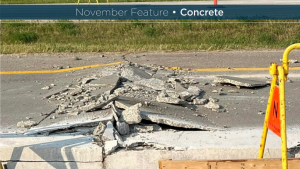The latest Track Record report assessing Infrastructure Ontario (IO) project oversight gives IO high marks for being on time and on budget but suggests its numbers could slip in future as its project mix changes.
Quantity surveying firm Hanscomb reported of the 56 IO alternative financing and procurement (AFP) projects that had reached substantial completion as of March 31, 2017, 53, or 95 per cent, were completed on budget and 39, 70 per cent, were on time.
Compared with four previous Track Record reports, the numbers show a slight dip from the highs in 2015 when 98 per cent of 45 projects had come in on budget and 73 per cent were on time.
The Hanscomb report, issued April 30, stated, “The AFP projects completed by March 31, 2017 were delivered well above industry standard benchmarks.”
Hanscomb wrote, addressing the budget results, “Rigorous project management practices employed for the duration of the project, and the transfer of risk to the consortium to manage change orders, contribute to these favourable outcomes.”
The warning about possible future performance pressures was issued as the report noted IO will be undertaking more civil and fewer institutional projects in future.
“On-time performance is strong but could benefit from continued monitoring of projects and lessons learned,” stated the report. “As Infrastructure Ontario’s portfolio ventures into the delivery of more civil AFP projects, complexity will increase and new strategies may be required to manage these types of projects.”
The definition of on-time was said to be project completion within 30 days of the specified completion date. The Hanscomb analysis noted the most-delayed transportation project came in 925 days late, a failure attributed to pre-construction site delays relating to cleaning and decommissioning that resulted in a late handover of the site. The build was finished in 2015.
The most-delayed health care project was 427 days late, attributed to “schedule management/scope change.”
These are outliers. We are extremely proud of IO’s overall track record
— Lee Greenberg
Infrastructure Ontario
Through a spokesperson, IO initially declined comment on the report during the recent provincial election campaign. IO further declined an interview request post-election given the new Progressive Conservative cabinet has not yet been sworn in.
IO spokesperson Lee Greenberg offered written responses to questions. He identified the health care project with the worst completion record as the Toronto Rehabilitation Institute, completed in 2012.
“An initial delay was caused by issues between Project Co. and its subcontractors. Unforeseen conditions subsequently discovered in the mechanical and piping systems exacerbated the delays. This in turn led to scope changes initiated by the owner. Responsibility for the delays was therefore shared,” Greenberg explained.
“Delays are never caused by one factor. In the case of the second project, Ontario Highway Service Centres, the vast majority of the sites were redeveloped and opened early or on-time. For various reasons, construction was delayed on the several remaining sites. In one case, an archeological discovery caused significant delay. On another site, remediation took longer than initially projected.
“These are outliers. We are extremely proud of IO’s overall track record.”
Greenberg said IO is in a continuous process of turning “experience into improvement.”
Mechanisms being used to improve performance, he said, include a Vendor of Record program to conduct third-party project reviews; the use of a tracking tool called the Lessons Learned Register, which incorporates recommendations from project reports into future procurement practices; and reviews by the IO Continuous Improvement committee.
“It’s also important to point out that Hanscomb’s review found that for the majority of the projects that experienced schedule delays, risk was transferred or shared with the private sector,” wrote Greenberg. “You can’t put a shovel in the ground without encountering risk. Big projects come with big risks.”
The IO spokesperson said the AFP model will continue to protect the taxpayer as the IO portfolio adds more civil projects.
“We are now moving into projects that are vastly more complex,” wrote Greenberg. “They happen at or below ground level. They occur in a dynamic, live environment, often impacting existing traffic or transit lines. As a result, these projects have more schedule challenges.
“The bottom line is that our approach to project delivery insulates the public from cost overruns. It will continue to do that.”











Recent Comments
comments for this post are closed